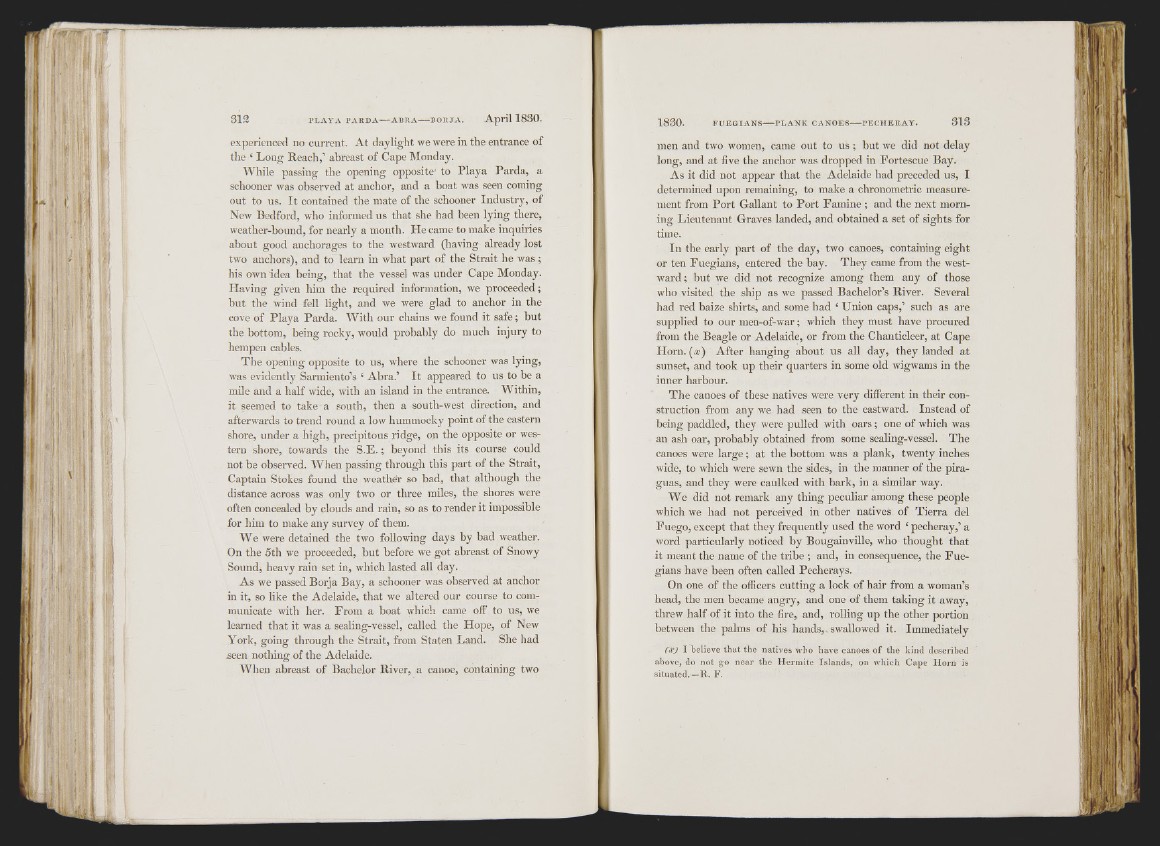
experienced no current. At daylight we were in the entrance of
the ‘ Long Reach,’ ahreast of Cape Monday.
AVhile passing the opening opposite' to Playa Parda, a
schooner was observed at anchor, and a boat was seen coming
out to us. It contained the mate of the schooner Industry, of
New Bedford, who informed us that she had been lying there,
weather-bound, for nearly a month. He came to make inquiries
about good anchorages to the westward (liaving already lost
two anchors), and to learn in what part of the Strait he was;
his own idea being, that the vessel was under Cape Monday.
Having given him the required information, we proceeded;
but the wind fell light, and we were glad to anchor in the
cove of Playa Parda. our chains we found it safe; but
the bottom, being rocky, would probably do much injury to
hempen cables.
The ojiening opjiosite to us, where the schooner was lying,
was evidently Sarmiento’s ‘ Abra.’ It appeared to ns to be a
mile and a half wide, with an island in the entrance. Within,
it seemed to take a south, then a south-west direction, and
afterwards to trend round a low hummocky point of the eastern
shore, under a high, precipitous ridge, on the opposite or western
shore, towards the S .E .; beyond this its course could
not be observed. AVlien passing through this part of the Strait,
Captain Stokes found the weather so bad, that although the
distance across was only two or three miles, the shores were
often concealed by clouds and rain, so as to render it impossible
for him to make any survey of them.
AVe were detained the two following days by bad weather.
On the 5th we proceeded, but before we got abreast of Snowy
Sound, heavy rain set in, which lasted all day.
As we passed Borja Bay, a schooner was observed at anchor
in it, so hke the Adelaide, that we altered our course to communicate
with her. From a boat which came off to us, we
learned that it was a sealing-vessel, called the Hope, of New
York, going through the Strait, from Staten Land. She had
seen nothing of the Adelaide.
AVhen abreast of Bachelor River, a canoe, containing two
men and two women, came out to u s ; but we did not delay
long, and at five the anchor was dropped in Fortescue Bay.
As it did not appear that the Adelaide had preceded us, I
determined upon remaining, to make a chronometric measurement
from Port Gallant to Port Famine ; and the next morning
Lieutenant Graves landed, and obtained a set of sights for
time.
In the early part of the day, two canoes, containing eight
or ten Fuegians, entered the bay. They came from the westward;
but we did not recognize among them any of those
who visited the ship as we passed Bachelor’s River. Several
had red baize shirts, and some had ‘ Union caps,’ such as are
supplied to our men-of-war; which they must have procured
from the Beagle or Adelaide, or from the Chanticleer, at Cape
Horn.(®) After hanging about us all day, they landed at
sunset, and took up their quarters in some old wigwams in the
inner harbour.
The canoes of these natives were very different in their construction
from any we had seen to the eastward. Instead of
being paddled, they were pulled with oars; one of which was
an ash oar, probably obtained from some sealing-vessel. The
canoes were large; at the bottom was a plank, twenty inches
wide, to which were sewn the sides, in the manner of the piraguas,
and they were caulked with bark, in a similar way.
AVe did not remark any thing peculiar among these people
which we had not perceived in other natives of Tierra del
Fuego, except that they frequently used the word ‘ pecheray,’ a
word particularly noticed by Bougainville, who thought that
it meant the name of the tribe ; and, in consequence, the Fuegians
have been often called Pecherays.
On one of the officers cutting a lock of hair from a woman’s
head, the men became angry, and one of them taking it away,
threw half of it into the fire, and, rolling up the other portion
between the palms of his hands, swallowed it. Immediately
Cxj I believe that the natives who have canoes of the kind descnbed
above, do not go near the Hermite Islands, on which Cape Horn is
situated.—R. F.